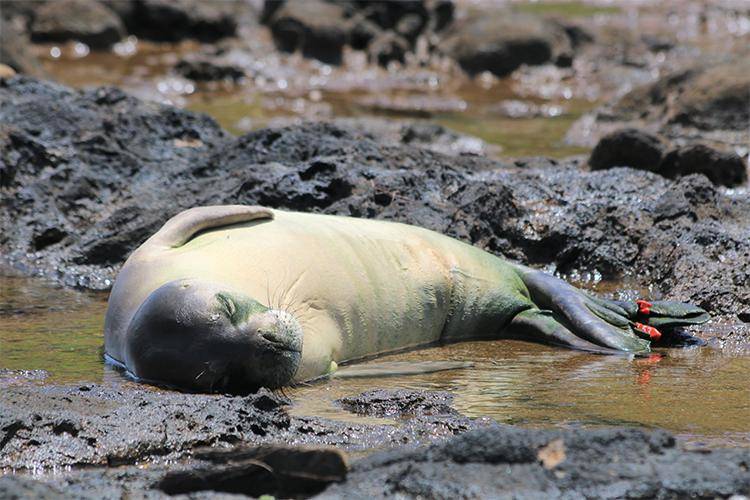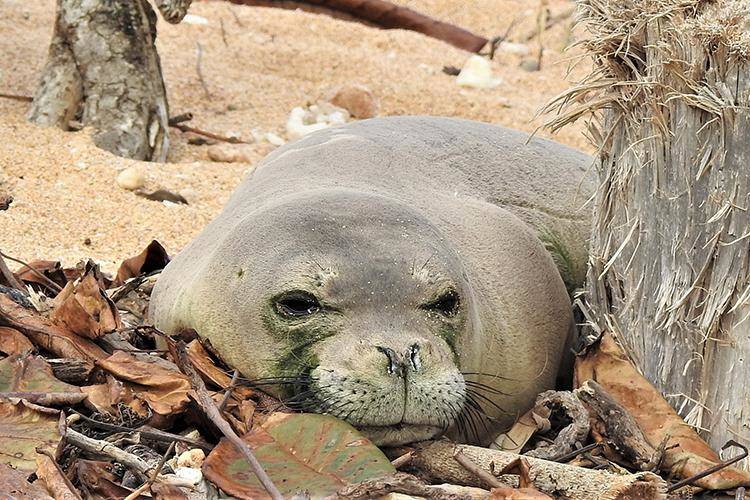Two of three dead monk seals on Kauai likely died from drowning in lay nets

COURTESY NOAA FISHERIES
Monk seal RL52 rested quietly in a rocky Kauai tide pool.

COURTESY NOAA FISHERIES
Monk seal RL52 hauled out high and dry on Kauai.


Post-mortem exams have revealed that two of the three Hawaiian monk seals that were found dead on Kauai’s north shore last year likely drowned in lay nets, wildlife officials said today.
Three seals were found dead separately — in September, November and December — all in the Anahola area of Kauai.
The unusual succession of deaths prompted an investigation by the National Oceanic and Atmospheric Administration Office of Law Enforcement, which was offering a reward of up to $20,000 Opens in a new tab for information leading to the issuance of a civil penalty or criminal conviction in one or both of these endangered Hawaiian monk seals.
The first seal, a juvenile male identified as RL52, was found dead around Sept. 10 after having just been spotted a week earlier nearby in good condition. The second seal, an untagged, juvenile female, was found dead around Nov. 18.
NOAA now believes the first two seals found in September and November likely died after becoming entangled in lay gill nets, a news release from the state Department of Land and Natural Resources said, based on recent lab test results and information gathered by law enforcement officials.
Post-mortem exams were delayed due to constraints caused by the COVID-19 pandemic, officials said.
Don't miss out on what's happening!
Stay in touch with breaking news, as it happens, conveniently in your email inbox. It's FREE!
NOAA said both seals were in good physical condition, with no evidence of underlying disease or injury, but fluid in their lungs suggested that they struggled to breathe before death.
The third seal that was found dead on Kauai in December was too severely decomposed, making it difficult to determine the cause of its death.
The use of lay gill nets has proven to be one of the top threats monk seals face in the main Hawaiian islands, NOAA said. They pose risks not only to monk seals, but to sea turtles and other protected species.
“While the vast majority of fishers in Hawaii continue to practice safe, sustainable, and pono fishing methods, some continue to fish recklessly, with devastating impact on native and endangered species,” said DLNR in a news release. “This is particularly common with lay gill net fishers.”
DLNR Division of Aquatic Resources rules Opens in a new tabrequire that a gill net used in the lay net fishing method not be left unattended for more than 30 minutes, and that it be inspected completely within two hours of being set. Also, lay nets may not be used from a half-hour after sunset to a half-hour before sunrise.
The best rule of thumb for lay net fishing, DLNR said, is “to always be present and vigilant when nets are set.”
Division of Conservation and Resources Enforcement officers have stepped up patrols, resulting in the removal of more unattended nets across the state.
“These monk seal deaths are, yet again, terrible and unnecessary losses,” DLNR Chair Suzanne Case said in the release. “Monofilament (made from nylon fishing line) lay nets are imported modern fishing gear that is indiscriminate and deadly and have been banned elsewhere in the U.S. We are in discussions regarding how best to ensure seals and turtles are protected given ongoing drownings in lay nets.”
Hawaiian monk seals Opens in a new tab, with a population of only about 1,400 remaining in the wild, are a critically endangered species.
The public is welcome to report illegal, unattended nets or seals observed close to nets to 643-DLNR or the free DLNRTip app.



